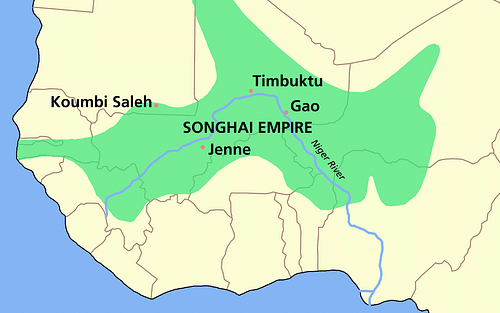The Songhai Empire Introduction - Songhai
The Songhai Empire (aka Songhay, c. 1460 - c. 1591 CE) replaced the Mali Empire (1240-1645 CE) as the most important state in West Africa (covering modern southern Mauritania and Mali). Originating as a smaller kingdom along the eastern side of the bend of the Niger River c. 1000 CE, the Songhai would expand their territory dramatically from the reign of King Sunni Ali (1464-1492 CE). With its capital at Gao and managing to control trans-Saharan trade through such centres as Timbuktu and Djenne, the empire prospered throughout the 16th century CE until, ripped apart by civil wars, it was attacked and absorbed into the Moroccan Empire c. 1591 CE.
Decline of the Mali Empire
The Mali Empire, located along the savannah belt between the Sahara desert to the north and the forests of southern West Africa (often referred to as the Sudan region), had prospered through its control of local and international trade, especially in gold and salt, since the mid-13th century CE. However, the empire began to collapse in the 1460s CE following civil wars, the opening up of competing trade routes elsewhere, and attacks from the nomadic Tuareg of the southern Sahara and then the Mossi people, who at that time controlled the lands south of the Niger River. Worse was to come, though, with the rise of the Songhai Empire, an ancient kingdom but now more powerful than ever. The Mali Empire would cling on to the western corner of its once vast territories, that is until the Moroccans arrived in the 17th century CE.
King Sunni Ali
The kingdom of Songhai dates back to at least the 9th century CE and was contemporary with the Ghana Empire (6-13th century CE) further to the east. It was dominated by and named after the Songhay (aka Sonhrai), a group of Nilo-Saharan-speaking peoples. Although conquered by the Mali Empire, the Songhai people would prove troublesome and powerful because they controlled river transport on the Niger. The Songhai kings made regular raids on Mali urban centres from the early 15th century CE and ultimately won their independence as the Mali kings lost their grip on several smaller subjugated kingdoms on the periphery of their empire.
Around 1468 CE, King Sunni Ali (aka Sonni Ali Ber) changed the traditional Songhai tactic of small and sporadic raids on its enemies to a more sustained campaign of permanent territorial expansion. With an army equipped with armoured cavalry and the only naval fleet in North Africa, which he deployed on the Niger River, Sunni Ali was able to conquer the rump of the old Mali Empire. As the Timbuktu chronicle, the Tarikh al-Sudan (c. 1656 CE) notes:
[He reigned] for 28 years, waged 32 wars of which he won every one, always the conqueror, never the conquered.
(quoted in de Villiers, 102)
https://www.ancient.eu/uploads/images/10158.png?v=1569516381

The Songhai king played on his image as a magician of the indigenous animist religion to strike fear into his enemies. He also effectively mixed leniency (conquered warriors were invited to join his own army, for example) with complete ruthlessness (infamously executing many of the particularly resistant Fulbe tribe). Hence, the king earned his epithet, ‘Sunni the Merciless’. Even more effective than these strategies was Sunni Ali’s battle tactics of attacking the enemy with overwhelming force and with the utmost speed. Conquered territories fell like dominoes and were divided up into provinces and ruled by a governor appointed by the king. Tribute was extracted from local chiefs, hostages taken and marriages of political alliance arranged, but at least Sunni Ali did build many dykes which improved the irrigation and agricultural yield of many areas.





0 General Document comments
0 Sentence and Paragraph comments
0 Image and Video comments
General Document Comments 0

